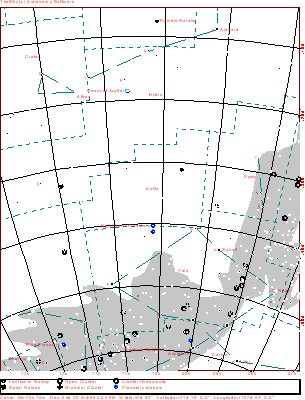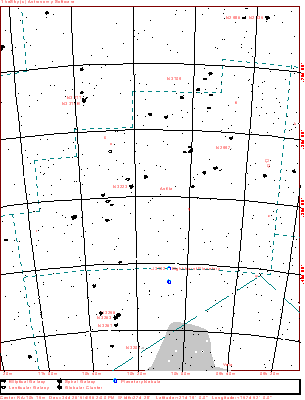
| Home | Deepsky Atlas | TheAstronews | Links | Solar System | ||||||

Hawaiian Astronomical SocietyConstellations: Antlia -- It's a Gas, Gas, Gas |
||||||||||
Boyle was a rather distinguished scientist. Born in 1627 in Ireland, he was raised in wealth as the 14th child of his family. He was educated in Eaton and then tutored in Switzerland. From 1645 he lived in Dorset (in England), engaging in a number of experiments and writing essays on a wide variety of subjects. One of his essays inspired Jonathan Swift to write Gulliver's Travels.
From 1665 to 1668 he lived in Oxford, and he worked with his assistant Robert Hooke to invent the air pump. He also studied the behavior of gases in some detail. This resulted in what we now call Boyle's Law: It states that at a given temperature, the pressure of a gas will vary inversely to the gas' volume.
In other accomplishments, he established that matter is made of a series of primary particles that combine to form corpuscles. Today, after a little more development, we call these things atoms and molecules.
Later in life, he continued his work, while living with his sister. He grew quite famous, and received many foreign visitors. He declined the presidency of the Royal Society of London in 1680. He endowed a series of lectures (called the Boyle Lectures, which continue to this day) with the goal of "proving the Christian Religion against notorious Infidels." By this, he meant the Roman Catholics. Boyle died in 1691 in London.

Click the map for a 916x1200 version of the above. Click here for a map better suited for use in the field.

This a more detailed view of the constellation. The map displays stars to magnitude 10, and deepsky objects to magnitude 12. Click here for a map better suited for use in the field.
 96k JPEG NGC2997 (Bennett 41b, the spiral galaxy at the bottom of the image) is one of Dreyer's remarkable objects. Described as very faint (mag. 10), very large (4'), it has a pronounced central condensation. Larger scopes should see knots in the spiral arms. Several galaxies hover around it, the brightest being NGC3001 (at the top, or north end, of the picture). It shines at mag. 12.3. The galaxy just to the north-west of NGC3001 is the 14.6 mag. ESO434-34. 96k JPEG NGC2997 (Bennett 41b, the spiral galaxy at the bottom of the image) is one of Dreyer's remarkable objects. Described as very faint (mag. 10), very large (4'), it has a pronounced central condensation. Larger scopes should see knots in the spiral arms. Several galaxies hover around it, the brightest being NGC3001 (at the top, or north end, of the picture). It shines at mag. 12.3. The galaxy just to the north-west of NGC3001 is the 14.6 mag. ESO434-34.
|
If you have any questions about the Hawaiian Astronomical Society
please
(link requires javascript).